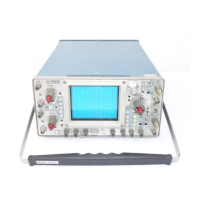Theory of
Operation—465B
Service
B
Sweep Gate
The
B Sweep Gate
circuit is comprised
of Q7053
and
Q7055. These
transistors
also form an
emitter-coupled
stage
where only
one transistor
can
be
conducting at any
time.
The input signal to
the stage is the
positive-going
trigger signal
from the B Trigger Firing
tunnel
diodeinthe
B Trigger
Generator circuit.
The signal at the
collector of
Q7053 is
connected to the B
Sweep Z-Axis Gate
circuit
(Q7093 and
Q7095)
to control crt
unblanking and to
generate the B+Gate
signal. The signal at
the collector of
Q7055
is connected to
the emitter
of
Sweep
Disconnect
Amplifier Q4565
in the B
Sweep Generator
circuit
to
initiate B
Sweep
generation.
Sweep
Control Integrated
Circuit
The Sweep
Control
integrated
circuit
is
U7375.
Several
functions are performed
in this stage,
depending on the
mode
of operation
of the instrument sweep
generators.
The
following is a brief
explanation of the
function
associated with each
pin of the
1C.
Pin 1 is
the positive
Auto Sense input. The
signal
connected
here comes from the
A Trigger
Firing tunnel
diode.
Pin 2 is a reference
input to the Auto Sense
circuit. A
fixed dc
level established by R7277
and R7276 is con-
nected here.
Pin 3 is
the + auto gate
terminal. In the AUTO mode of
operation, if
no
trigger signals
are
applied to
pin
1 ot
U7375
during
the approximately 100
milliseconds follow-
ing
the end of holdoff,
the gate level at pin 3
steps LO to
turn Q7256 on which
initiates
a
sweep.
Pin 4 is
not used in this application.
Pin 5 is the
input terminal for
negative voltage
supply.
Pin 6
is the auto
gate
timing terminal. R7272
and
C7273
determine the
amount of
time between the
end
of
holdoff
and the
generation of
the auto
gate.
Pin 7
output lights the
TRIG LED when atriggered
gate
has occurred.
Pin 6 is
the holdoff
timing terminal. The RC
network
connected to
this terminal
(selected
by
the
A TIME/DIV
switch)
determines the length of
holdoff time.
Pin 9 is the
ground terminal.
Pin 10 is the
Holdoff output terminal. The gate
level
present here is
LO during sweep holdoff time
and HI
otherwise.
Pin 11
output lights the READY LED when
operating in
the single sweep
mode.
Pin 12 is the single sweep mode
terminal. When +5 volts
is
applied to this terminal
the sweep operates in the single
sweep mode: when the terminal is left open
or grounded
the sweep
operates in the repetitive mode.
Pin 13 is not used
in this operation.
Pins
14 & 15 are the single sweep
reset terminals.
Pushing the SINGLSWP
button
preparesthe
single sweep
circuitry to respond to the next triggering event, and also
causes
the READY LED to come on.
Pin 16 is the holdoff
start input terminal. The HI sweep
reset gate
pulse from the sweep generators is
applied here
to
initiate sweep holdoff.
Pin 17 is
the sweep disable output terminal.
The gate
level at this
terminal
is
HI during holdoff and LO
otherwise.
Pin 16 is the sweep
lockout input. +5 volts
applied to
this terminal
disables all
sweep
action.
Pin 19 is the auto
mode terminal. Grounding
this
terminal enables auto sweep operation.
Pin 20 is the input terminal for
positive voltage supply.
Holdoff
Timing
A resistor
and capacitor network
located in the A
and B
Timing
Switch circuit connects
to pin 8 of
U7375
via pin 8
of J4571.
Various resistor and
capacitor combinations
switch into the
circuit, depending on the
setting
of
the A
TIME/DIV
switch. At sweep end, pin 8 of U7375
is released,
and the
timing capacitors in the holdoff
timing network
start to
charge. Q7465 is biased off
during the sweep
holdoff
time
by a LO
at pin 10 of U7375
which allows
the
voltage at
pin 8 to rise due
to charging
of
the
timing
capacitors.
When the charge
on
the
capacitors rises to
approximately +4 volts at pin
8,
pin
17
goes HI and
pin 10
goes HI to turn on
Q7465. The holdoff
timing
capacitors
REV
A SEP
1979
3-13

